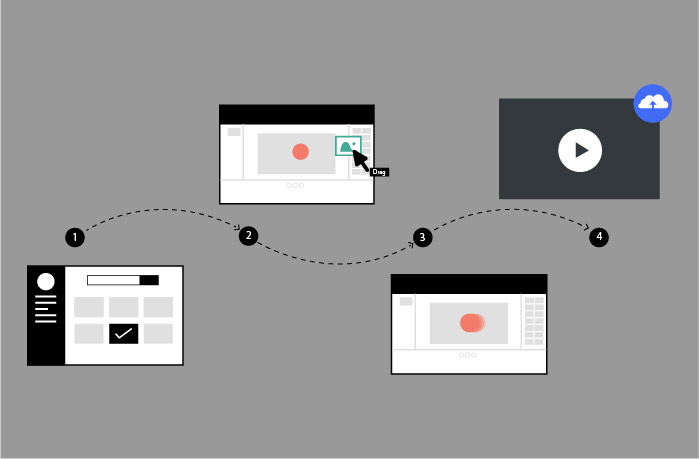There are more possibilities than ever before to play with video now that it is on the increase. Our preferred method? Graphics in motion. It’s a great way to convey a tale with these distinctive animated videos. As a result, we’re seeing them all over the place, from ads to Facebook.
You can tell a tale without being bound by the limitations of live-action video, which is particularly appealing to storytellers and producers. Despite the fact that motion graphics are a great way to explore, not all are the same.
We’ve been developing motion graphics for almost a decade, and we can attest to this. With our extensive experience (and possibly making every beginner mistake ourselves), we know exactly what you need to go through this procedure successfully.
Let us know whether you’re ready to produce your first motion graphic (or if you’re looking for ways to make your next one less stressful). Here you’ll discover a step-by-step tutorial for creating motion graphics, as well as some time and energy-saving suggestions.
An Overview: How To Make Motion Graphics
Before we get started, it’s vital to know what a motion graphic is and how it works. Particularly important when working with collaborators who aren’t well-versed in the various forms of video.
Animations that communicate a story are known as motion graphics. Animated visuals and kinetic text may both be used to tell a story in motion graphics. They can either be 2D or 3D. So many alternatives are what make them so appealing.
Let’s take a look at an example of motion graphics:
Guidelines Before You Begin Creating Motion Graphics Video
We all know creating motion graphics can be a pretty challenging task to complete. To succeed, you need to plan ahead of time and keep everyone on your team on the same page:
Prepare a creative, powerful brief:
This should include any and all pertinent information that will aid everyone involved in the process, from your writer to your animator. You are free to alter any template to your liking.
Come up with a strong distribution plan ahead of time:
You must know if your promotion staff is not prepared from the start, they will find themselves scurrying to obtain the views you desire. To avoid this, ensure that your plan is well recorded.
Additionally, you can always experiment with different video distribution strategies to increase the visibility of your motion graphic.
Take customer approvals:
We cannot emphasize this enough (and will do so throughout this). Ascertain sign-off at each stage to maintain everyone’s sanity. We purposefully built this procedure such that each stage builds on the previous one. You should not go to the following level unless and until everyone provides their approval.
Don’t be shy to ask for help when you need it:
There can be certain situations in which you might feel you’re stuck or your teammates are unable to finish things before the deadline; in such a scenario, you can always consider hiring an outsourcing animation company. If so, check our list of top animation outsourcing companies.
All clear now? Let’s get started!
How To Create A Motion Graphics Video – The 4 Doable Steps
Step 1: Come up with a story and put it on paper (Scriptwriting)
The creation of a motion graphic does not begin with a storyboard. It begins with a tale that has been condensed into a screenplay. Even though motion graphics are often brief, lasting between 30 seconds and 3 minutes, they require a screenplay, also known as a script, to contain dialogue or plot direction.
Finding a story isn’t easy; therefore, before indulging in it, you need to ask yourself the following set of questions:
- Who is my target audience?
- What action do I want them to take?
- What do I want to teach them?
- How do I want them to feel?
As you begin writing your script, you need to keep a closed eye on the word count. While it may be tempting to jam as much information as possible into your script, simplicity and clarity are critical.
Additionally, keep in mind that one of the benefits of motion is that it enables you to convey your tale in a variety of ways. Unlike static infographics, which depend solely on pictures and language to convey a narrative, motion graphics use movement, music, and other elements to assist in the storytelling process.
As you craft your motion graphics video script, you need to have a clear idea of which parts of your narrative are going to fall in which category:
Onscreen text: Text-only storytelling is ideal for scenarios such as trade exhibitions where audio is not available. It’s also a clever approach to engage individuals, as reading requires them to pay more attention.
Voiceover: In marketing, we frequently discuss the importance of discovering your brand’s voice. Voiceover provides an opportunity to accomplish just that. Because VO is used in conjunction with onscreen animation, the two operate in unison.
However, be cautious of over-scripting. Having your voiceover artist read your past year’s sales figures is a waste of time when the same information can be displayed swiftly and efficiently onscreen via some animated data visualization.
Voiceover and kinetic (text): As previously said, audio and visualization work well together for data visualizations, explainer videos, and any other time something onscreen has to be clarified or labeled.
Visuals-only: Even though this category is commonly seen in the industry, you can still create motion using engaging graphics without adding any text.
Step 2: Visualize your words (Storyboarding)
After you’ve completed the screenplay phase, you may begin visualizing it during the storyboard step. This is the stage at which the screenplay and graphics are combined, and the final product begins to take form.
Begin your storyboarding meetings with a collaborative brainstorming session with members of your design and production teams. For us, this entails bringing together the screenplay, producer, and storyboard sketch artist (a.k.a. designer).
Before you begin, you’ll want to sketch up frames on a whiteboard and go through the final script together. Then you may begin sketching concepts for the script’s development.
Step 3: Put your visuals into the design
As is the case with any visual effort, style and color convey just as much as the content itself. Even when adhering to your own brand guidelines, little design changes may have a significant influence on the user experience.
Once you’ve sketched out your storyboard, you can begin turning it into actual designs.
Note down: Everything created at this level is incorporated into the final animation phases, so take your time with the details. Additionally, it helps if the individual who created the storyboards is also responsible for the design.
Write down your visual notes during this stage and have them reviewed by your production team (and any other stakeholders) before sending them on to the animation team for inclusion in the final cut.
Step 4: Animate your creative designs
Here we are at the final phase of the process. Everything comes together during the animation process. If you’ve done your job and obtained approval for each stage, by the time you begin animating, everyone should have a decent notion of what’s coming.
Following are the set of elements you particularly need to think about:
Timing: Pacing is critical to the success of any motion graphic. Too hurried, and folks will not “understand” what you’re trying to communicate. If you go too slowly, you may lose people’s interest. The pace keeps the audience engaged. Consider clever modifications to increase the level of excitement.
Animation style: This is not simply about fading in and out of scenes; the way you transition from one point to the next has an effect on the story’s cohesiveness. Eliminating a scene communicates finality, whereas progressing from A to B keeps the plot moving. Bear in mind that you do not want to perplex or jar your viewers.
Sound effects: What works for one person may not work for another. In the opinion of some animators, it’s best to let the other aspects speak for themselves. Others believe they’re a must-have item. The trick is to just employ elements that are essential to your tale and don’t detract from it.
It’s A Wrap
If you’ve done your job successfully, you should be proud of the end product and have learned a few things in the process. Moreover, we hope you’ll have the courage to experiment with more complex motion graphics.
On the other hand, if you’re looking for any top-rated motion graphics studios to get your motion graphics video done, consult BuzzFlick – a video animation agency offering animation and video production services, including motion graphics services, at an affordable cost.




